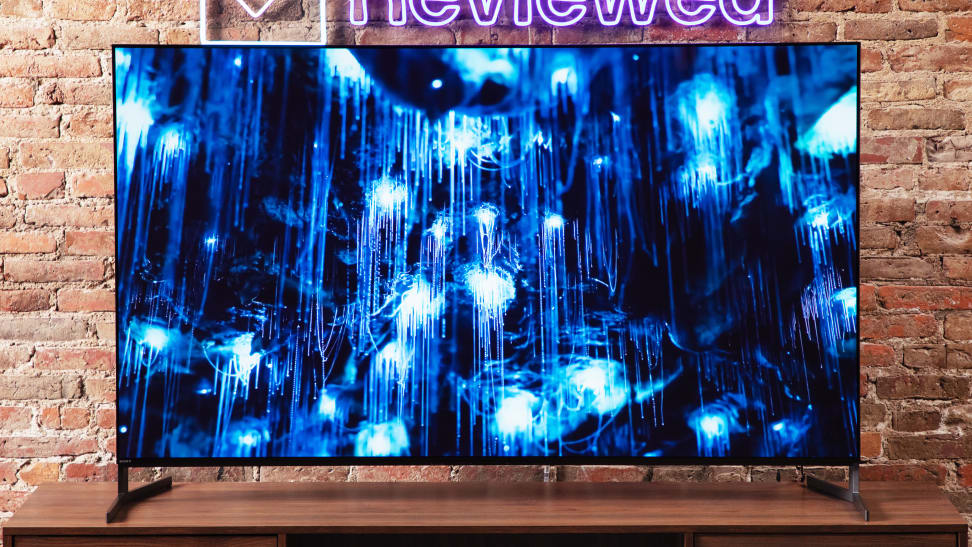 Credit:
Reviewed / Timothy Renzi
Credit:
Reviewed / Timothy Renzi
Products are chosen independently by our editors. Purchases made through our links may earn us a commission.
When it comes to the best TVs you can buy, there are two types that stand above the rest: OLED TVs and quantum-dot LED TVs. Both premium display technologies have advantages and disadvantages depending on your living space and personal preferences.
But the days of being forced to choose between these top-tier TV technologies is at an end. At CES 2022, Samsung received an Innovation Award for its QD-OLED TV, an all-new display type that combines OLED technology with quantum dots—a true best of both worlds situation. And a few months later, the Samsung S95B was released. Shortly thereafter, Sony released its own QD-OLED TV, the A95K. It should be mentioned that both Samsung and Sony use panels made by Samsung Display—a subsidiary of Samsung Electronics. Samsung Display was originally created as a joint venture by Samsung Electronics and Sony before Samsung Electronics bought Sony out in 2012 (confused yet?).
These early models were limited to two sizes—55 and 65 inches. Since then, we’ve seen an expansion of available sizes with 77-inch versions of these TVs' successors: the Samsung S95C and the Sony A95L.
Now that we’ve entered the era of QD-OLED, it’s important to understand the advantages of this technology. Let’s start with the basics.

The S95C is the follow-up to Samsung's first QD-OLED TV, and it offers even better performance than its predecessor.
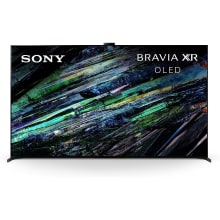
The Sony A95L is the best TV we've ever seen, with incredible highlights, accurate color, and attractive styling.
What is an OLED TV?
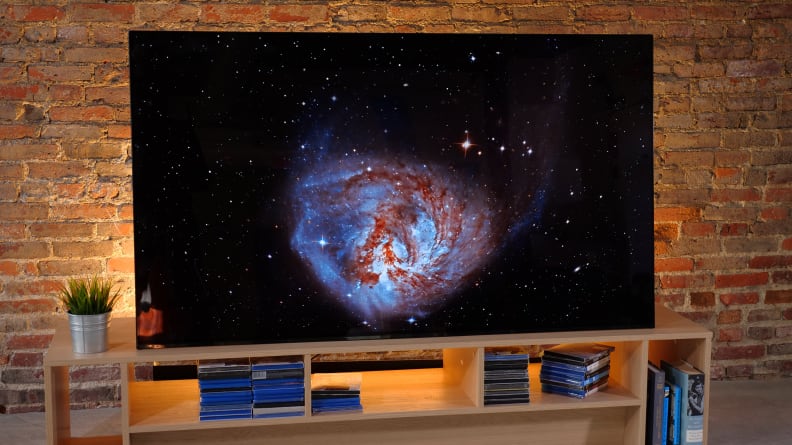
Because the pixels found in OLED displays are self-illuminating, the space in between stars is free to get as dark as possible.
OLED (organic light-emitting diode) TVs are celebrated for their unparalleled contrast, ultra-wide viewing angles, and all-around terrific picture quality.
The secret to OLED’s success has to do with its pixels. While traditional LED TVs rely on complicated LED backlight systems for pixel illumination, the pixels of an OLED TV are self-illuminating, meaning they turn on and off independently of one another.
To put it in practical terms, if you’re watching a scene set in outer space on an OLED TV, the darkness will appear completely and truly black, with the regions surrounding every dotted star totally free of light bloom. The so-called infinite contrast ratio of an OLED TV has positive, cascading effects on nearly every other aspect of performance. It allows for an incredibly detail-rich picture, pinpoint-accurate colors, and shadow tones free from that nasty banding effect. The self-emissive nature of OLED displays also allows for the widest viewing angles on the market today.
TV brightness is often reported in “nits,” a common shorthand for candela per square meter (cd/m2)—a measurement of luminance output. And if OLED TVs have one performance-related pitfall, it’s that they’re not nearly as bright as the high-end LED TVs that occupy the same price bracket. Even in HDR, the brightest OLED we’ve ever tested tops out at just under 900 nits of sustained brightness—over half as dim as a premium LED TV. This makes them a less-than-ideal pick for folks with brightly lit living spaces or people craving a dazzlingly bright viewing experience. From a shopping standpoint, there’s also a wider variety of premium LED TVs to choose from compared to similarly priced OLED TVs.
What is a quantum-dot LED TV?
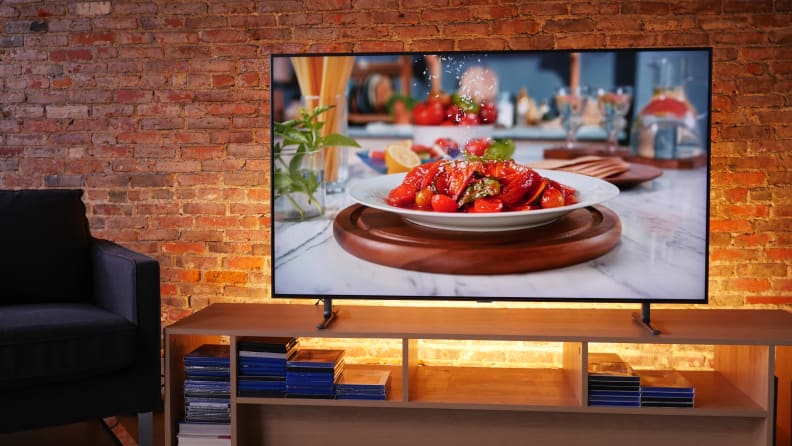
QLED, a term coined and popularized by Samsung, refers to TVs that feature quantum dot technology.
If you’re shopping for a traditional LED TV in a higher, OLED-level price bracket, there’s a very good chance that your ideal candidate will come with quantum dots in tow. TV brands refer to quantum-dot displays in different ways; Samsung and TCL call them “QLED” TVs while Sony calls its proprietary quantum dot technology “Triluminos Color.” There are currently two ways to apply quantum dots to a screen, but the fundamental effect on viewing is the same.
Quantum dots are microscopic nanocrystals that emit red or green light when struck with blue light. They allow a display to use bright, blue light to illuminate its pixels, increasing the saturation of red and green in the process. TVs use "additive" color, and since red, green, and blue are their primary colors, the enhanced red/green saturation extends to the millions of secondary and tertiary colors that the primary colors are used to create.
In short, quantum-dot TVs typically offer a brighter, more-colorful picture than LED TVs without quantum dots. In fact, the brightest TVs we’ve ever tested have all been quantum-dot TVs—some climbing higher than 2,000 nits in HDR. These make them excellent picks for people with bright living rooms, or for folks who are seeking bright, rich colors.
But until early 2022, all quantum-dot TVs were LED TVs, which means they lacked the many advantages of OLED TVs. Most LED TV panel types also struggle to maintain their picture quality when viewed at off angles, too.
What if you didn’t have to choose between OLED and quantum dots? What if there was a technology that blended the incredible contrast of OLED with the bright, colorful look of quantum-dot LED?
Enter QD-OLED.
What is a QD-OLED TV?
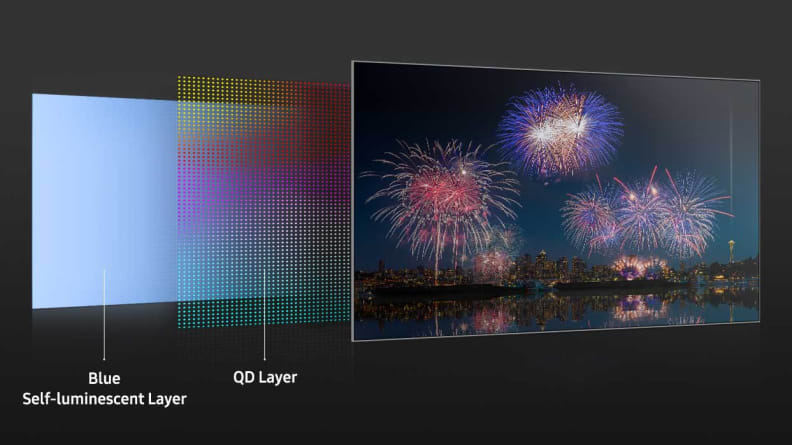
QD-OLED uses blue light to illuminate red and green quantum dots, allowing for a brighter, more colorful OLED display.
Even before its release, QD-OLED (quantum-dot organic light-emitting diode) technology quickly became the most talked-about and sought-after tech in the TV industry.
QD-OLED TVs combine the self-emissive nature of OLED displays with the brightness- and color-boosting qualities of quantum-dot displays by using blue light to illuminate red and green quantum dots. These TVs are inherently brighter than traditional OLED TVs while maintaining their perfect black levels, wide viewing angles, and incredible overall contrast. And although OLED TVs already tend to produce rich, well-saturated colors, the addition of quantum dots widen a QD-OLED’s color palette even further.
What QD-OLED TVs can I buy right now?
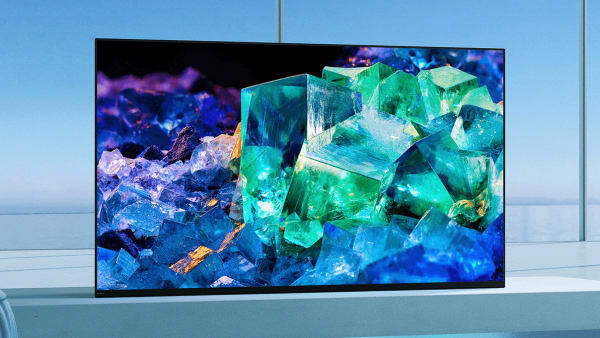
The 65-inch Sony A95K will use Samsung's QD-OLED panels. It's the first QD-OLED TV from Sony.
Right now, Samsung Display is the only manufacturer producing QD-OLED TV panels, and Sony is the only other brand releasing its own spin on the technology—for now.
If you want the newest QD-OLED TVs, the aforementioned S95C and A96L are your only current options. However, Samsung will be bringing a new version of this TV to the market this year: the S95D.

The S95C is the follow-up to Samsung's first QD-OLED TV, and it offers even better performance than its predecessor.

The Sony A95L is the best TV we've ever seen, with incredible highlights, accurate color, and attractive styling.



